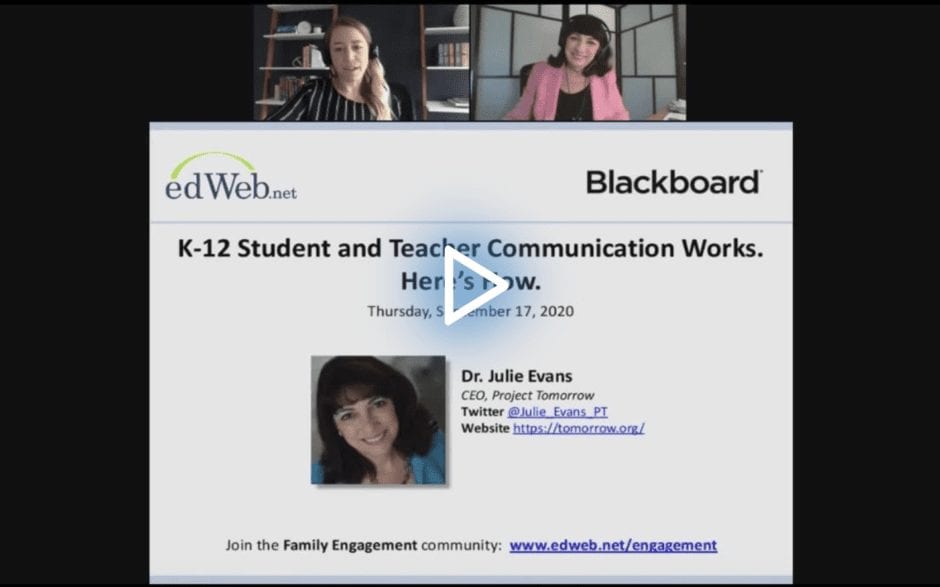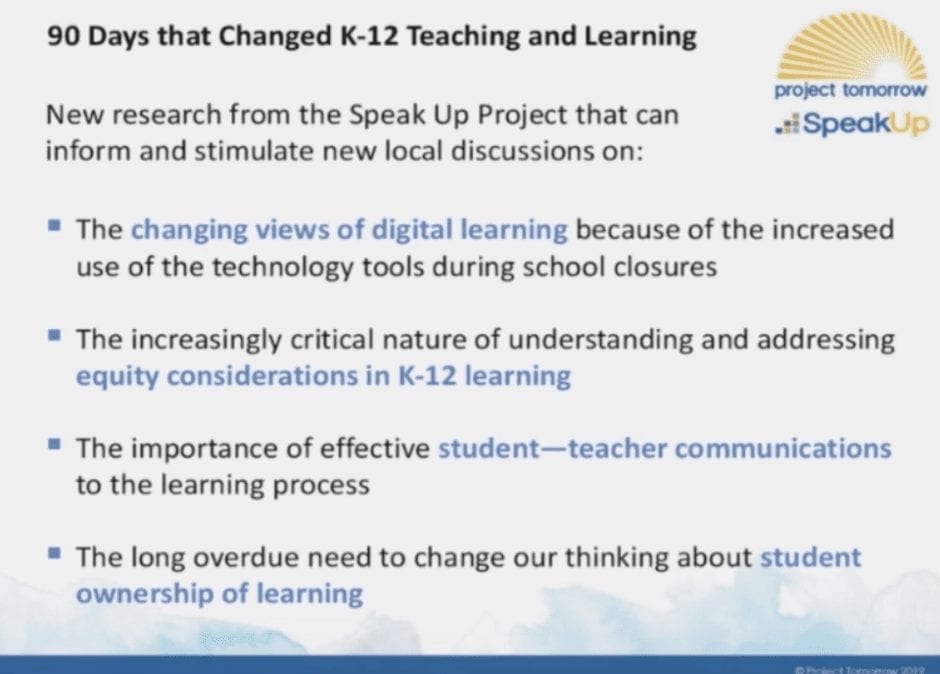Teacher-Student Digital Communication Makes for Good Learning
By Michele Israel
With remote learning still at play, students now rely on virtual engagement with their teachers to have questions answered and assignments clarified. With the appropriate tools and tech access, instructional assistance from afar can be academically beneficial.
So explained Dr. Julie Evans, Chief Executive Officer of Project Tomorrow, in an edWebinar sponsored by Blackboard, examining findings from the program’s 2020 annual research project, Speak Up, for which 10,000 K-12 students nationwide shared their preferences and expectations for two-way communications with their teachers.
The results? Digital tools are part of students’ virtual communications backpack with their teachers and schools and are becoming vital to academic achievement, which Project Tomorrow and Blackboard highlight in their joint report Strengthening the Bonds of Communications. The report is one of four reports featured in the executive brief series 90 Days that Changed K-12 Teaching & Learning.
Communications Conversion
Without the opportunity for immediate or regular face-to-face support from teachers, students are using texting, social media posts, mobile app alerts, and personal emails for the interaction and support they need.
Dr. Evans said the Speak Up survey revealed that during the school closure period, there was a significant increase in students and teachers having two-way communication. For example, survey data showed:
- Student and teacher texting increased significantly during the sudden shift to digital learning because of COVID-19 school closures.
- While only 16% of students in grades 6-8 said they regularly texted with their teachers before school closures, almost one-third of students reported this was a regular occurrence during school closures.
- There was an 83% increase in teachers saying they want to be able to learn how to use social media not only to communicate with parents but also with students.
Student and teacher communication is particularly effective when it’s purposeful, develops trusting relationships, and supports students’ skill development.
Dr. Evans pointed to several tools teachers and students relied on (and continue to depend on) to facilitate two-way communications and information sharing during school closures.
Email is not a new way students communicate with teachers, but it became more prevalent when schools were closed. Students appreciated that teachers responded quickly to their specific concerns—a homework assignment that needed clarification or something they struggled with. They could, for instance, easily and immediately send a screenshot to the teacher who would give the issue direct attention.
Text messaging has become a tool of choice for teacher-student communication (in the past, it was a way to interact with teachers and parents; between 2015-2018, only about 14% of teachers texted with students). Now, two-thirds of students report that they are regularly texting to communicate with their teachers. Teachers find that students are more likely to text questions than pose them in class.
School websites provide students with updates on school events and classroom news. Dr. Evans said they like the repository of information about assignment due dates, projects, and the location of curricula and tests. But, students say they would like alternate ways to get school information, with social media among them.
Most critical to the evolving approaches to two-way communication is ensuring that teachers recognize their students’ needs to individualize and personalize interactions.
Remote Interaction: What Is Required
What remote learning has unveiled, explained Dr. Evans, is that many students do not have the tech resources distance learning requires. “The idea of students having access to high-quality, safe, and appropriate technology to empower meaningful remote learning was a big awakening for many folks around the country,” she said.
Equity of access (and appropriate learning environments, i.e., not just a computer hotspot somewhere) during this time of COVID is critical to students’ academic success, engagement with teachers and socio-emotional well-being. Many students, especially those in urban communities and majority-minority schools, already lacked the digital tools or programs necessary to perform in the classroom. Some schools have addressed the tech deficits by providing devices students can bring home, like Chromebooks and even personal smartphones.
Student data privacy and online safety are significant concerns. As students frequently use tech devices to communicate and learn, they are at cyber risk. Schools and parents must be responsible and accountable for protecting learners’ in the virtual realm. For example, many districts, explained Dr. Evans, are discussing ways to ensure that personal and school networks do not become intertwined, and further monitoring social media use via risk dashboards.
Dr. Evans advised that as these virtual forms of communication become more and more the norm, it is important to be mindful of “balancing the convenience, the just-in-time [learning and access] that we saw during the school closures, and expediency of all of that with what really are the responsibilities as we think about the role of students and the role of teachers in these communications opportunities.”
This edWeb broadcast was sponsored by Blackboard.
This article was modified and published by eSchool News.
About the Presenter
Dr. Julie A. Evans is the CEO of Project Tomorrow and is the founder of the heralded Speak Up Research Project which annually collects and reports on the authentic views of 400,000 K-12 students, parents and educators on education issues each year. Dr. Evans serves as the chief researcher on the Speak Up Project as well as leading research efforts on the impact of digital content, tools and resources in both K-12 and higher education. Prior to this position, Dr. Evans enjoyed a successful entrepreneurial career in the technology industry including with two education technology startups. She is a graduate of Brown University and earned her doctorate in educational leadership from the University of California, San Diego and California State University San Marcos. Dr. Evans serves on several boards and advisory councils and is a frequent speaker and writer on K-12 and higher education issues around digital learning.
Join the Commmunity
Family Engagement & Community Outreach in K-12 is a free professional learning community on edWeb.net where district and school administrators, teachers, and families can explore all aspects of family engagement and its positive effects on student achievement.
At Blackboard, we’re shaping the future of education with big ideas that are transforming the face of education. Every day we’re helping millions of people around the world find new ways to learn, connect and advance. With innovative technologies and solutions we’re bringing them closer to the knowledge they seek and the potential they can achieve.
Michele Israel writes about the ideas and best practices that are shared in edWeb’s edWebinars so they can spread innovative and best practices to the education community. Michele owns Michele Israel Consulting, LLC, which serves large and small educational, nonprofit, media, corporate, eLearning, and blended-learning organizations to bolster products and programs. Her rich career spans over 25 years of successfully developing educational materials and resources, designing and facilitating training, generating communication materials and grant proposals, and assisting in organizational and program development. In addition to lesson plans and other teacher resources, Michele’s portfolio includes published articles covering a range of educational and business topics.





Comments are closed.